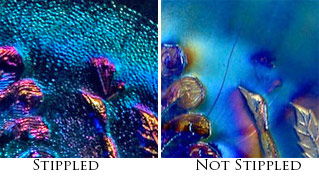Heavy Grape by Imperial
By Carl and Eunice Booker
Imperial’s Heavy Grape pattern is another one of the grape patterns that was very popular in the prime time of old carnival glass. While Imperial did not make this pattern in as many shapes as some of the other companies producing carnival glass, there are enough shapes to make this pattern one that could fill several cabinets considering the variety of shapes and colors available. This pattern was No. 700 based on the flute or wide panel exterior pattern (not the interior pattern).
It seems that one is always challenged when trying to write about a popular carnival glass pattern to be sure that all the bases are covered. Unfortunately, this seldom happens. It always seems that someone has written about some special color, shape, or treatment that has been overlooked. We apologize on behalf of any other writers who have written about this pattern and brought out some very special feature that we have overlooked. We guess that this is why we keep writing and reading carnival glass reports and newsletters.
Listed shapes in the Imperial Heavy Grape pattern are ten-inch chop plate, eight-inch plate, six-inch plate, large berry bowl, small berry bowl, eight-inch bowl, one handle nappy, fruit bowl and base, punch bowl and base, and punch cup.

The photo above shows an array of colors of the Heavy Grape plates. From left are vaseline, amber, purple, marigold, and a marigold chop plate.
Below, from left, are clambroth, aqua/teal, smoke, and green.
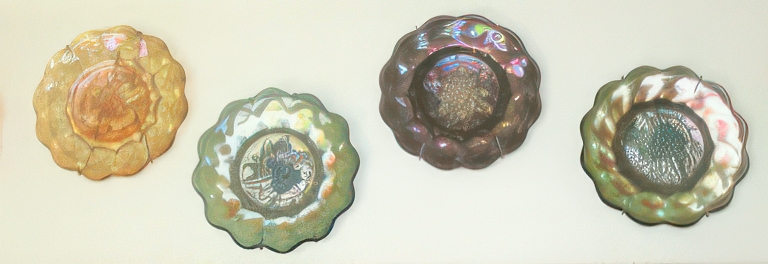
We really hate to try to list the colors in which this pattern was made. There is always someone who sees a color one way while another sees the same color another way. We will make an attempt to list all of the colors that have been reported and maybe some that have not. (Please understand that not all shapes were made in all colors.) Marigold, marigold with a frosted camphor type finish, clambroth, amethyst/purple, lavender, green, lime green, helios green, ice green, olive green, blue, sapphire blue, aqua, teal, white, smoke, amber, and vaseline.
This pattern comes with some unusual features. Most of the bowls and plates have a quilted finish.
The smallest size plates are felt to have been made from the small berry bowl rather than a separate mold. There are very few small plates known.
Jerry and Carol Curtis wrote a very interesting article about a Heavy Grape berry set that used an experimental process where the exterior iridescence was painted on instead of being sprayed. The large bowl had a marigold finish while the small bowls had a light blue finish. It makes one wonder how many pieces depended on the whim of the worker that day. (Maybe this is why there are so many variants and different colors known to exist in all carnival glass patterns.)
Now, if this isn’t enough variety for you, some of the pieces come with a stretch finish. This seems to happen more often on the chop plates than other shapes. The effect can be quite stunning.
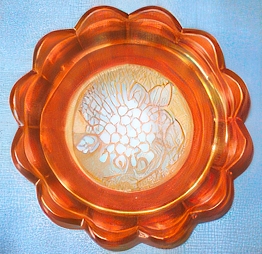
This marigold bowl has a frosted camphor finish in the bottom.
In the color listing we list marigold with frosted camphor-type finish. We bought this bowl some time ago due to the unusual, frosted type glass that shows in the base. It has the usual exterior paneling, but no quilting and has a starred base. The interior is stippled and has the leaves, branches, and bunch of grapes. To the best of our ability, we counted thirty-six grapes. We would like to know if anyone else has a bowl like this one. It measures six and one fourth inches across the top opening.
We once found a Heavy Grape bowl of this same size in a small antique shop in Alabama. We looked at it, but weren’t impressed, so we put it back in its dust circle and left it. When we got home, we thought we should check it and discovered that we should have bought it The piece was cobalt blue. The next time we were in that area we went back to the shop and discovered that the bowl was still there in its dust circle. We bought the bowl and took it to a convention and had it for sale. A prominent collector/dealer came in our room and picked out a few pieces to buy and just said, “I’ll be back. Hold these pieces for me.” Included in the items he bought was the blue Heavy Grape bowl. We have no idea where this bowl is today, but we sort of wish we hadn’t sold it. We don’t really have sellers’ remorse but just know we should have done a bit more background work before offering it for sale.
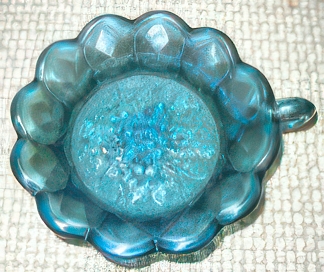
This unusual sapphire color nappy caught the Bookers’ eyes.
We do have a nice collection of eight‐inch plates in eight colors. We’re still looking for a white and a blue one. The chop plate is known in white, but there do not seem to be any eight‐inch plates in white. Wouldn’t it be great to find a chop plate along with the eight‐inch plate in cobalt blue? We’ll keep looking.
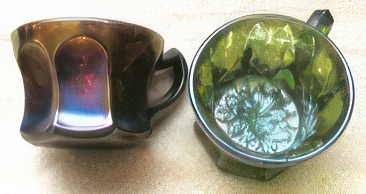
These hard-to-find punch cups are represented here in purple and green.
Sources: Burns. Imperial Carnival Glass Identification and Value Guide; Carwile. Standard Encyclopedia of Carnival Glass, 12th edition; Doty. Website.
Photos courtesy of the Bookers.
This article first appeared in the ICGA Pump in the March 2015 issue and is reprinted with permission.

